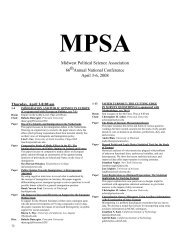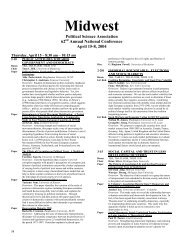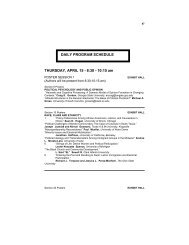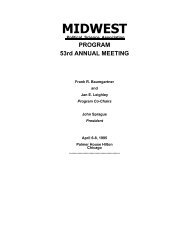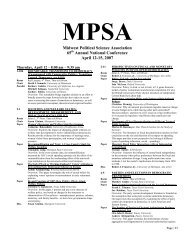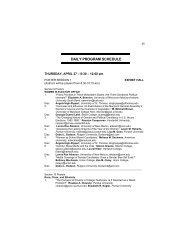PaperPaperDisc.A Simple Game-Theoretic Model of Suicide TerrorismSusan M. Jellissen, University of Illinois, Urbana-ChampaignAnirrudha Mitra, University of Illinois, Urbana-ChampaignOverview: We present a dynamic game between an incumbentregime, a subject population, and a terrorist organization thatclaims to represent the population in its desire to depose theregime.Adaptive Tactics: Terrorist Targeting and Regime TypeStephen C. Nemeth, University of IowaOverview: Using ITERATE data and by adapting the selectioninstitutions argument in Bueno de Mesquita et al. (2005), I seekto show that terrorists operating in democratic states will selectand attack qualitatively different targets than in autocratic states.Walid Phares, Florida Atlantic University17-5 INTERNATIONAL INSTITUTIONS ANDDOMESTIC POLITICSRoomChairPaperPaperPaperPaperDisc.TBA, Fri 8:30 amMonika A. Nalepa, Rice UniversityU.S. Domestic Politics and the United NationsMichael B. Hawes, Georgetown UniversityOverview: This paper is an examination of the effect of partisancontrol of domestic political institutions on U.S. participation inthe United Nations system.The Influence of International Agreements on ForeignPolicy PreferencesMichael R. Tomz, Stanford UniversityOverview: The paper directly measures the effect ofinternational agreements on foreign policy preferences, and itovercomes problems of endogeneity that have hamperedprevious research. Data from experiments reveal when/howinternational agreements matter.A Transnational View: Turkish Nonstate Actors and theEuropean UnionZeynep Alemdar, Okan UniversityOverview: The paper argues that nonstate actors useintergovernmental organizations to alter the preferences of theirstates in favor of their own position and examines whether andhow Turkish nonstate actors use the EU.Neopatrimonialism and Postcommunist States: ExposingBuilt-in Assumptions in Theories of InternationalCooperationNeil Abrams, University of California, BerkeleyOverview: Theories of international cooperation make priorassumptions about the structure of the state that prove unreliableonce applied beyond the advanced-industrialized countries. Irely on postcommunist case study evidence to illustrate thispoint.Gregory D. Miller, College of William & MaryMonika A. Nalepa, Rice University18-4 INFORMATION PROCESSINGRoom TBA, Fri 8:30 amChair Michael D. Parkin, University of MinnesotaPaper An Integrated, Computational Model of the 2000Presidential ElectionSung-youn Kim, University of IowaCharles Taber, Stony Brook UniversityOverview: In this study, we examine whether the integration ofon-line and memory-based processing models is not onlytheoretically necessary but also whether the integrated modelout performs the other models in terms of explaining theempirical data.Paper <strong>Political</strong> Innovation, Novel Appeals, and PatternedResponsesRobert Huckfeldt, University of California, DavisCarl Palmer, University of California, DavisJohn Ryan, University of California, DavisOverview: This paper examines the use of decision-makingheuristics in complex decisions regarding politically innovativeappeals. The paper depends on the experimental measurementof response latencies to assess patterns of association in longterm memory.PaperPaperPaperDisc.Religious Language and Implicit <strong>Political</strong> CognitionBethany L. Albertson, University of ChicagoOverview: This paper explores the mechanisms of religiouspersuasion, hypothesizing that religious language affectsattitudes at both an implicit and explicit level. I test thesehypotheses experimentally, relying on an Implicit <strong>Association</strong>Test.Thinking and Attitude PolarizationMathieu Turgeon, University of Texas, AustinOverview: Using four survey-experiments I have conducted inthree different countries (Brazil, Canada, and the U.S.), I showthat increased motivation and opportunity to think leads toattitude polarization.Public Comprehension of <strong>Political</strong> Events: 9/11 and the IraqWarAdam J. Berinsky, Massachusetts Institute of TechnologyDonald R. Kinder, University of Michigan, Ann ArborLiz Suhay, University of Michigan, Ann ArborOverview: We consider how preexisting politicalpredispositions (measured in 2000) influenced how people madesense of 9/11 and the Iraq war in 2002 and how thisunderstanding in turn affected their opinions on foreign policyand security issues in 2004.Mariya Y. Omelicheva, Purdue UniversityTereza Capelos, Leiden University19-14 STRATEGIC VOTINGRoomChairPaperPaperPaperPaperPaperDisc.TBA, Fri 8:30 amChristopher Wlezien, Temple UniversityExceptions to Duverger's Law in Canada and Britain: TheRole of Federalism v. InformationEmily Clough, University of North TexasOverview: Canada and Britain both exhibit more than twoparties at the district level despite the fact that both have singlememberplurality systems. This paper looks at federalism andinformation as factors regulating strategic voting and Duverger'sLaw.Strategic Third Party Voting in Congressional ElectionsJeffrey T. Doyle, Washington State UniversityOverview: Using the National Election Survey, I explore therelationship between noncompetitive Congressional elections,the theory of wasted votes, and the fluctuation in third partyvoting.Identifiability of Coalitions, District Magnitude andStrategic VotingThomas Gschwend, University of MannheimOverview: I test a theory that proposes two factors (districtmagnitude, pre-election identifiability of coalitions) todetermine the types of strategies employed and the number ofstrategic voters that can be observed across 30 different electionstudies.Breaking Duverger's Law: Sincere and Strategic Voting inU.S. ElectionsThomas Knecht, University of DenverAhmed Amonette, Universit of DenveryKelli Ann Sindeband, University of DenverSeth Stulgis, University of DenverOverview: Our paper examines the individual-level factors thatdistinguish sincere from strategic voters in U.S. Presidentialelections.Protest Voting: The Other Tactical ChoiceDaniel M. Kselman, Duke UniversityEmerson Niou, Duke UniversityOverview: This paper develops a formal model to predict thecircumstances under which voters (in plurality elections) willabandon their most-preferred candidate to cast a PROTESTVOTE. We then test these predictions on survey data fromCanada and the UK.Scott J. Basinger, SUNY, Stony Brook132
19-15 VOTING IN RED AND BLUE STATESRoomChairPaperPaperPaperPaperPaperDisc.TBA, Fri 8:30 amKyle L. Saunders, Colorado State UniversityBehind the Red-Blue Divide: The Causes of GeographicPolarizationDavid A. Hopkins, University of California, BerkeleyOverview: Voting patterns in American elections have becomemore geographically distinctive since the 1970s. This paperanalyzes survey data in order to test the common claim that thisphenomenon has been driven by the increased salience of socialissues.Taxing, Spending, Red States, and Blue States: The <strong>Political</strong>Economy of Redistribution in the US Federal SystemDean P. Lacy, The Ohio State UniversityDonald P. Lacy, The Ohio State UniversityOverview: Since 1984, states that receive the most federalspending per tax dollar that their citizens pay have votedincreasingly for Republican presidential candidates. We explainthe reason for this federal fiscal paradox.The Matter with Kansas: Rural Republican Voting inPresidential ElectionsSeth C. McKee, University of North Carolina, CharlotteOverview: Exit polls show a striking increase in Republicanvoting among rural residents in recent presidential elections. Iuse exit poll data and census data to explain the increase inRepublican voting among rural residents in presidentialelections.Is There Really Anything the Matter with Kansas? ANationwide AssessmentShannon C. Nelson, University of Illinois, ChicagoOverview: What's the Matter with Kansas suggests Kansans nolonger vote in their economic interests. Precise economicmeasures are presented to test this thesis and to ascertainwhether this pattern is evident nationwide.What's the Matter with Massachusetts: Why Minority PartyGovernors WinStacey L. Pelika, University of Wisconsin, MadisonHannah B. Goble, University of Wisconsin, MadisonOverview: We investigate a sample of recent gubernatorialraces in which candiates of the state's minority party wereelected. In particular, we examine hypotheses regarding the roleof partisanship in the vote and candidate portrayals inadvertising.Daron R. Shaw, University of Texas, Austin20-2 THE POLITICS OF PRESIDENTIALNOMINATION CAMPAIGNSRoomChairPaperPaperPaperDisc.TBA, Fri 8:30 amKenneth E. Fernandez, University of Nevada, Las VegasThe Winnowing Effect in Presidential NominationCampaignsThomas G. Hansford, University of South CarolinaA. J. Barghothi, University of South CarolinaOverview: We investigate winnowing effect in presidentialnomination campaigns via duration analysis. We empiricallytest our hypotheses using data we have collected for the sevenpost-reform presidential nomination campaigns (1980-2004).Prairie Progressives: The Iowa Democratic PresidentialCaucuses, 1972-2004Laurence Horton, University of EssexOverview: The Iowa caucuses are a media event. Iowa’sprimacy ensures it undue attention. Rather than an opportunityfor lesser known candidates to emerge, the caucuses act as ahandicap, consuming disproportionate resources with littlereturn.Why Do Democrats Keep Nominating Senators (Who Lose)?Christian A. Farrell, University of OklahomaOverview: The structure of party organizations leads todiffering decisions on what kinds of candidates to nominate forpresident. This can be used to explain why Democrats keepnominating unelectable Senators and Republicans nominatemore electable governors.Larry Butler, Rowan University22-11 THE INFLUENCE OF PUBLIC OPINION ONPOLICYMAKINGRoomChairPaperPaperPaperPaperDisc.TBA, Fri 8:30 amPatrick Sellers, Davidson CollegeThe Role of Public Opinion in Presidential DecisionMaking: The Case of Iranian Hostage CrisisCengiz Erisen, SUNY, Stony BrookOverview: This paper analyzes the role of public opinion inparticular crises between Iran and the U.S. The main objectiveis to evaluate whether the public is really influential inpresidential decision-making on foreign issues.Tough Choices: Determinants of Senators' Trade VotesClaire V. Kramer, Franklin & Marshall CollegeAdam P. Brinegar, Duke UniversityJennifer L. Merolla, Claremont Graduate UniversityJohn H. Aldrich, Duke UniversityOverview: In this paper, we test the linkages betweenconstituency opinion, party organization, and key trade votes inthe Senate from 1988 to 1994 using data from the ANES SenateElection Study. We argue that the influence of different levelsof constituencyExploring Changing Preferences for Public Goods in theUnited StatesSean Nicholson-Crotty, University of Missouri, ColumbiaOverview: This paper investigates variation in citizen supportfor government programs from which they can expect no privatebenefit and compares that measure to an existing indicator of"mood" regarding levels of U.S. government activity.When Made to Choose: Do Senators Follow the President orPublic Opinion?Jose D. Villalobos, Texas A&M UniversityOverview: I focus on Republican senators who are crosspressuredbetween public opinion, loyalty to the president, andtheir own interests. Using fractional polynomial time analyses tomeasure behavior change, I find that members choose to followthe public.Patrick Sellers, Davidson College22-17 PARTY POLARIZATION (Co-sponsored withVoting Behavior, see 19-19)RoomChairPaperPaperPaperPaperTBA, Fri 8:30 amBrian F. Schaffner, American UniversityDo You See What I See? Perceptions of Party Differencesand <strong>Political</strong> ParticipationCraig Goodman, Texas Tech UniversityGregg Murray, SUNY, BrockportOverview: This manuscript explores the voting behavior ofcitizens who do not see differences between the two majorparties in the United States. Our results suggest that those whofail to see differences are less likely to vote.The Left Shift in American Politics: Affect, Information,and PolarizationMichael MacKuen, University of North Carolina, Chapel HillEvan Parker-Stephen, University of North Carolina, ChapelHillOverview: <strong>Political</strong> affect, rooted in personality traits andinformation channels, shapes people's beliefs about politicalparties. Historical data confirm a powerful system ofasymmetric attribution biases that yield the Left Shift inAmerican politics.Birds of a <strong>Political</strong> Feather: Assessing <strong>Political</strong> Segregationin American CountiesMelissa J. Marschall, Rice UniversityWendy M. Rahn, University of MinnesotaOverview: Using an additive measure of segregation, Theil’s H(Fisher et al. 2004; Reardon and Firebaugh 2002), wedecompose political segregation levels in select Americancounties into three components.Polarization and Party Politics: The Changing Face ofAmerican Tolerance?Michael H. Murakami, University of California, BerkeleyOverview: I use survey data collected over the last 30 years toexamine if increasing party polarization among attentive, strong133
- Page 1 and 2:
MidwestPolitical Science Associatio
- Page 4 and 5:
9-4 STATE BUILDING AND BUREAUCRATIC
- Page 6 and 7:
14-1 GLOBALIZATION AND SECURITYRoom
- Page 8 and 9:
PaperPaperDisc.The Divide: African
- Page 10 and 11:
29-210 INFORMAL ROUNDTABLE: CULTURE
- Page 12 and 13:
PaperDisc.Defining Federalism: The
- Page 14 and 15:
PaperDisc.estimates connections amo
- Page 16 and 17: 3-26 THE DETERMINANTS OF ECONOMICGR
- Page 18 and 19: PaperPaperPaperDisc.Bad Civil Socie
- Page 20 and 21: PaperPaperDisc.Voting Patterns in t
- Page 22 and 23: PaperDisc.'Going Local': Candidate
- Page 24 and 25: PaperPaperDisc.90Reflections on Lit
- Page 26 and 27: Presenter Out of Time: Examining th
- Page 28 and 29: is: to what extent are intergovernm
- Page 30 and 31: Presenter Economic Inequality, Its
- Page 32 and 33: PaperPaperPaperPaperDisc.during the
- Page 34 and 35: 10-3 BACK TO EUROPE? THE EU AND"EUR
- Page 36 and 37: PaperPaperPaperDisc.Interested Part
- Page 38 and 39: PaperPaperthatDisc.Don't Know, Don'
- Page 40 and 41: Disc.Suzanne Soule, Center for Civi
- Page 42 and 43: epistemology which is attentive to
- Page 44 and 45: 37-3 CONSTITUTIONAL INTERPRETATIONA
- Page 46 and 47: 47-201 INFORMAL ROUNDTABLE: RELIGIO
- Page 48 and 49: PaperPaperDisc.terms and reciprocal
- Page 50 and 51: PaperPaperPaperDisc.116Education, E
- Page 52 and 53: 19-202 INFORMAL ROUNDTABLE: YOUNG A
- Page 54 and 55: 26-6 ASIAN AMERICAN POLITICSRoomCha
- Page 56 and 57: PaperPaperPaperDisc.of how partisan
- Page 58 and 59: PaperPaperDisc.124An Experimental S
- Page 60 and 61: PaperPaperDisc.Policy Windows, Atte
- Page 62 and 63: Friday, April 21 - 8:30 am - 10:15
- Page 64 and 65: PaperPaperPaperDisc.The Determinant
- Page 68 and 69: PaperDisc.partisans is causing chan
- Page 70 and 71: 28-201 INFORMAL ROUNDTABLE: DEWEY'S
- Page 72 and 73: 35-4 THE EFFECTS OF REDISTRICTING O
- Page 74 and 75: Presenter Regulation, Enforcement a
- Page 76 and 77: Friday, April 21 - 10: 30 am - 12:1
- Page 78 and 79: PaperPaperDisc.144Regional Minority
- Page 80 and 81: PaperPaperDisc.Administration of Gl
- Page 82 and 83: PaperPaperPaperDisc.The Paradox Soc
- Page 84 and 85: Disc.("Policy Mood") since 1972 usi
- Page 86 and 87: Disc.likelihood of a filibuster is
- Page 88 and 89: 38-301 POSTER SESSION: COMPARATIVEI
- Page 90 and 91: 54-1 SOCIAL ACTIVISM AND CIVICENGAG
- Page 92 and 93: 3-203 INFORMAL ROUNDTABLE: THE LEGA
- Page 94 and 95: PaperPaperPaperPaperDisc.Toward Res
- Page 96 and 97: Presenter The Shanghai Cooperation
- Page 98 and 99: PaperPaperPaperDisc.poised to becom
- Page 100 and 101: PaperDisc.chapter in Foucault's int
- Page 102 and 103: PaperDisc.Campaign Ad Images as Sig
- Page 104 and 105: 43-6 INDEPENDENT SCRUTINY OF AGENCI
- Page 106 and 107: Friday, April 21 - 3:45 pm - 5:30 p
- Page 108 and 109: 6-2 PARTIES AND PARTY DISCIPLINERoo
- Page 110 and 111: PaperDisc.assesses the impact of co
- Page 112 and 113: 19-301 POSTER SESSION: VOTING BEHAV
- Page 114 and 115: 24-9 WHO LEADS: UNTANGLING THERELAT
- Page 116 and 117:
PaperPaperPaperDisc.182Understandin
- Page 118 and 119:
Paper The Rehnquist Court and the N
- Page 120 and 121:
PaperDisc.Revenge of Socialist Supe
- Page 122 and 123:
Saturday, April 22 - 8:30 am - 10:1
- Page 124 and 125:
PaperDisc.South Korean Public Opini
- Page 126 and 127:
PaperDisc.several other variables b
- Page 128 and 129:
22-15 PRESIDENTIAL APPROVAL (Co-spo
- Page 130 and 131:
PaperDisc.never seems to provide us
- Page 132 and 133:
PaperPaperPaperDisc.Polarization an
- Page 134 and 135:
PaperDisc.Networks of Local Governm
- Page 136 and 137:
47-203 INFORMAL ROUNDTABLE: RELIGIO
- Page 138 and 139:
PaperPaperPaperPaperDisc.Between De
- Page 140 and 141:
11-9 NEW THEORIES AND THUS NEWDEBAT
- Page 142 and 143:
PaperPaperPaperAre Political Market
- Page 144 and 145:
26-9 MINORITY REPRESENTATIONRoomCha
- Page 146 and 147:
PaperDisc.Evolving Political Machin
- Page 148 and 149:
PaperPaperPaperDisc.economic gains
- Page 150 and 151:
PaperPaperPaperDisc.A Social Versus
- Page 152 and 153:
Saturday, April 21 - 1:45 pm - 3:30
- Page 154 and 155:
PaperPaperDisc.Riptides in Ontario:
- Page 156 and 157:
PaperPaperPaperDisc."works," a stat
- Page 158 and 159:
PaperPaperPaperPaperDisc.Preference
- Page 160 and 161:
PaperPaperPaperDisc.226that encoura
- Page 162 and 163:
32-12 POLITICAL PARTIES IN ELECTION
- Page 164 and 165:
PaperPaperDisc.Challenging Others o
- Page 166 and 167:
52-3 SOCIAL POLICIES: CHALLENGES AN
- Page 168 and 169:
Saturday, April 22 - 3:45 pm - 5:30
- Page 170 and 171:
PaperDisc.It's Not the Economy Stup
- Page 172 and 173:
15-10 DEMOCRACY, EQUALITY, AND PEAC
- Page 174 and 175:
Presenter Polarization, Public Opin
- Page 176 and 177:
PaperDisc.John S. Mill and Alexis d
- Page 178 and 179:
PaperDisc.Lobbying by Transportatio
- Page 180 and 181:
42-202 INFORMAL ROUNDTABLE: DOMESTI
- Page 182 and 183:
Presenter Female Athletes Making He
- Page 184 and 185:
PaperPaperDisc.Micro-Level Determin
- Page 186 and 187:
PaperDisc.Governmental Structure, P
- Page 188 and 189:
PaperDisc.Social Class Identity and
- Page 190 and 191:
33-9 PRESIDENTIAL-CONGRESSIONALRELA
- Page 192 and 193:
PaperPaperDisc.Equal Employment Opp
- Page 194 and 195:
Sunday, April 23 - 10:30 am - 12:15
- Page 196 and 197:
PaperPaperPaperDisc.State Legitimac
- Page 198 and 199:
18-14 THE STUDY AND MEASUREMENT OFR
- Page 200 and 201:
28-14 ROUSSEAU RECONSIDEREDRoomChai
- Page 202 and 203:
PaperDisc.The Judicial Treatment of




